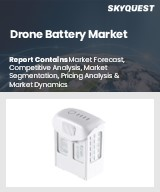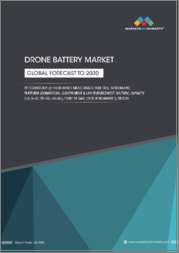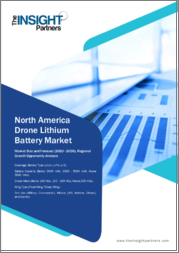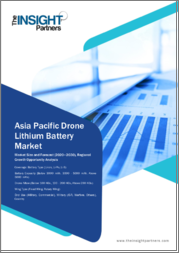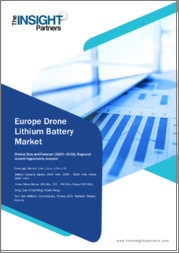
|
시장보고서
상품코드
1660566
세계의 드론 배터리 시장 : 드론 유형별, 배터리 유형별, 배터리 용량별, 최종 사용자별, 지역 규모별, 동향, COVID-19의 영향, 예측(-2030년)Global Drone Battery Market: Analysis By Drone Type, By Battery Type, By Battery Capacity, By End User By Region Size and Trends with Impact of COVID-19 and Forecast up to 2030 |
||||||
세계 드론 배터리 시장 규모는 2024년에 10억 2,000만 달러를 기록했고, 2030년까지 25억 달러에 이를 전망입니다. 드론 배터리, 특히 리튬과 니켈 기반 화학 물질을 사용하는 배터리는 드론(UAV)의 중요한 동력원으로 작동 효율과 비행 시간을 결정합니다. 리튬 배터리는 에너지 중량비가 높고 드론의 장시간 사용에 요구되는 소형 경량의 전력을 제공합니다. 내구성과 안정성이 평가되는 니켈 기반 배터리는 까다로운 환경에서 드론에 안정적인 전원을 제공합니다. 이러한 배터리 기술의 진보와 최적화는 UAV의 능력을 향상시키고 다양한 산업에서의 활용을 확대하는데 핵심적인 역할을 합니다.
휴대용 및 고에너지 밀도 전원 공급 장치의 요구에서 생겨난 이러한 배터리는 공중 촬영에서 물류에 이르기까지 고급 드론 응용 시대에 필수적입니다. 최근 시장 수요의 급증은 기술 혁신, 드론의 내구성과 전력요구의 향상, UAV 기술의 재생가능에너지원에 대한 의욕이 높아짐에 따라 드론의 사용이 급격히 증가하고 있기 때문입니다. 드론이 상업 및 산업 활동에 통합됨에 따라 드론 배터리의 성능과 효율성은 매우 중요하며, 지속적인 진화와 최적화가 UAV 산업의 궤적에 중점을 둡니다. 시장은 2025년-2030년의 예측 기간에 CAGR 16.01%의 성장이 예상됩니다.
이 보고서는 세계 드론 배터리 시장에 대한 조사 분석을 통해 시장 역학, COVID-19의 영향, 경쟁 구도 등에 대한 정보를 제공합니다.
목차
제1장 주요 요약
제2장 소개
- 드론 배터리 :개요
- 드론 배터리의 정의
- 드론 배터리를 선택할 때 고려해야 할 중요한 점
- 드론 배터리의 세분화 : 개요
- 드론 배터리의 세분화
제3장 세계 시장 분석
- 세계의 드론 배터리 시장 : 분석
- 세계의 드론 배터리 시장 : 개요
- 세계의 드론 배터리 시장 규모
- 세계의 드론 배터리 시장 : 드론 유형별(미니 쿼드, 마이크로 쿼드)
- 세계의 드론 배터리 시장 : 배터리 유형별(리튬 폴리머, 니켈 카드뮴, 니켈 수소)
- 세계의 드론 배터리 시장 : 배터리 용량별(3,000mAh 미만, 3,000-5,000mAh, 5,000-10,000mAh, 10,000mAh 초과)
- 세계의 드론 배터리 시장 : 최종 사용자별(농림업, 인프라 모니터링, 에너지·수도 서비스, 건설, 채광, 기타)
- 세계의 드론 배터리 시장 : 지역별(아시아태평양, 북미, 유럽, 라틴아메리카, 중동 및 아프리카)
- 세계의 드론 배터리 시장 : 드론 유형의 분석
- 세계의 드론 배터리 시장 : 드론 유형별, 개요
- 세계의 미니 쿼드 드론 배터리 시장 규모
- 세계의 마이크로 쿼드 드론 배터리 시장 규모
- 세계의 다른 드론 유형의 드론 배터리 시장 규모
- 세계의 드론 배터리 시장 : 배터리 유형의 분석
- 세계의 드론 배터리 시장 : 배터리 유형별, 개요
- 세계의 리튬 폴리머 드론 배터리 시장 규모
- 세계의 니켈 카드뮴 드론 배터리 시장 규모
- 세계의 니켈 수소 드론 배터리 시장 규모
- 세계 드론 배터리 시장 : 배터리용량 분석
- 세계의 드론 배터리 시장 : 배터리 용량별, 개요
- 세계의 3,000mAh 미만 드론 배터리 시장 규모
- 세계의 3,000-5000mAh 드론 배터리 시장 규모
- 세계의 5,000-10000mAh 드론 배터리 시장 규모
- 세계의 10,000mAh 초과 드론 배터리 시장 규모
- 세계 드론 배터리 시장 : 최종 사용자 분석
- 세계의 드론 배터리 시장 : 최종사용자별, 개요
- 세계의 농림업용 드론 배터리 시장 규모
- 세계의 인프라 모니터링용 드론 배터리 시장 규모
- 세계의 에너지·수도 서비스용 드론 배터리 시장 규모
- 세계의 건설용 드론 배터리 시장 규모
- 세계의 채광용 드론 배터리 시장 규모
- 세계의 다른 최종 사용자용 드론 배터리 시장 규모
제4장 지역 시장 분석
- 아시아태평양의 드론 배터리 시장 : 분석
- 아시아태평양의 드론 배터리 시장 : 개요
- 아시아태평양의 드론 배터리 시장 규모
- 아시아태평양의 드론 배터리 시장 : 지역별(중국, 일본, 한국, 인도, 기타 아시아태평양)
- 중국의 드론 배터리 시장 규모
- 일본의 드론 배터리 시장 규모
- 한국의 드론 배터리 시장 규모
- 인도의 드론 배터리 시장 규모
- 기타 아시아태평양의 드론 배터리 시장 규모
- 북미의 드론 배터리 시장 : 분석
- 북미의 드론 배터리 시장 : 개요
- 북미의 드론 배터리 시장 규모
- 북미의 드론 배터리 시장 : 지역별(미국, 캐나다, 멕시코)
- 미국의 드론 배터리 시장 규모
- 캐나다의 드론 배터리 시장 규모
- 멕시코의 드론 배터리 시장 규모
- 유럽의 드론 배터리 시장 : 분석
- 유럽의 드론 배터리 시장 : 개요
- 유럽의 드론 배터리 시장 규모
- 유럽의 드론 배터리 시장 : 지역별(프랑스, 영국, 독일, 이탈리아, 기타 유럽)
- 프랑스의 드론 배터리 시장 규모
- 영국의 드론 배터리 시장 규모
- 독일의 드론 배터리 시장 규모
- 이탈리아의 드론 배터리 시장 규모
- 기타 유럽의 드론 배터리 시장 규모
- 라틴아메리카의 드론 배터리 시장 : 분석
- 라틴아메리카의 드론 배터리 시장 : 개요
- 라틴아메리카의 드론 배터리 시장 규모
- 중동 및 아프리카의 드론 배터리 시장 : 분석
- 중동 및 아프리카의 드론 배터리 시장 : 개요
- 중동 및 아프리카의 드론 배터리 시장 규모
제5장 COVID-19의 영향
- 세계의 드론 배터리 시장에 대한 COVID-19의 영향
- 세계의 드론 배터리 시장에 대한 COVID-19 이후의 영향
제6장 시장 역학
- 성장 촉진요인
- 건설 부문에서의 채용 증가
- 군사 및 방위에서의 사용 증가
- 산업 전체에서의 드론 채용 증가
- 배터리 기술의 진보
- 규제 지원과 표준화
- 소비자용 드론의 성장
- 과제
- 대체 연료 솔루션 수요 급증
- 에너지 저장 솔루션으로서의 슈퍼커패시터의 채용 증가
- 시장 동향
- 자동 드론이나 AI 구동 드론의 성장
- 드론 배송의 확대
- 도심항공모빌리티(UAM)와 드론 택시
- 긴급 서비스의 채용 증가
- 스웜 드론의 상승
- 지방과 원격지에서의 사업 확대
- 친환경 솔루션으로의 전환
- 새로운 드론 스타트업 진입 증가
- 차세대 스마트 배터리 기술의 등장
제7장 경쟁 구도
- 세계의 드론 배터리 시장 : 경쟁 구도
- 세계 드론 배터리 시장 기업: 제품
제8장 기업 프로파일
- Sony Corporation
- Panasonic Corporation
- SZ DJI Technology Co., Ltd.
- Autel Robotics
- Shenzhen Grepow Battery Co., Ltd.
- MaxAmps
- Tuthill Corporation(EaglePicher Technologies)
- RRC Power Solutions
- Arotech Corporation(Epsilor)
- Denchi Power Ltd.
- Vision Aerial
- LG Chem(LG Energy Solution)
- DNK Power
The global drone battery market in 2024 stood at US$1.02 billion and is likely to reach US$2.50 billion by 2030. Drone batteries, especially those utilizing lithium and nickel-based chemistries, serve as the critical power source for Unmanned Aerial Vehicles (UAVs), determining their operational efficiency and duration of flight. Lithium batteries, favored for their high energy-to-weight ratio, offer drones the lightweight, compact power needed for extended use, which is crucial for tasks ranging from aerial photography to precision agriculture. Nickel-based batteries, valued for their durability and stability, provide a reliable power source for drones in more demanding environments. The advancement and optimization of these battery technologies are central to enhancing UAV capabilities and expanding their use in various industries.
Originating from the need for portable, high-energy-density power sources, these batteries have become indispensable in the era of advanced drone applications, ranging from aerial photography to logistics and beyond. The recent upsurge in their market demand is attributed to the exponential growth in drone usage, driven by technological innovation, increased endurance and power requirements of drones, and a growing appetite for renewable energy sources in UAV technology. As drones become more embedded in commercial and industrial activities, the performance and efficiency of drone batteries are poised to be pivotal, making their continued evolution and optimization a central focus in the UAV industry's trajectory. The global drone battery market is projected to grow at a CAGR of 16.01% during the forecast period of 2025-2030.
Market Segmentation Analysis:
By Drone Type: Based on the drone type, the market report has segmented the global drone battery market, into three segments namely, Mini Quad, Micro Quad, and Other. In 2024, the Mini Quad segment emerged as the largest in the drone battery market primarily due to the explosive popularity of drone racing and freestyle flying. These activities require compact, agile drones with batteries that provide high discharge rates for dynamic maneuverability and speed, driving a high volume of sales in the Mini Quad sector. Further, the Mini Quad segment, during the forecasted period of 2025-2030, is expected to be the fastest-growing segment, owing to continuous innovations in battery technology that are projected to further enhance the performance and duration of Mini Quad flights. Coupled with the increasing mainstream appeal of drone sports and recreational flying, the demand for advanced, longer-lasting batteries in the Mini Quad domain is set to surge, outpacing other drone battery market segments.
By Battery Type: Based on the Battery Type, the global drone battery market can be divided into three segments namely, Lithium Polymer, Nickel Cadmium, and Nickel Metal Hydride. In 2024, the Lithium Polymer (LiPo) segment stood as the largest in the drone battery market due to its unparalleled energy density and adaptability, which significantly enhances drone performance. LiPo batteries' ability to provide longer flight times and their flexibility in design cater perfectly to the diverse and expanding demands of both recreational and commercial drone users. Looking forward to the forecast period of 2025-2030, the LiPo battery segment is anticipated to maintain its rapid growth trajectory. This is driven by the ongoing advancements in LiPo technology that promise even greater improvements in energy efficiency, safety, and operational longevity, ensuring they remain the preferred choice as drone applications become more sophisticated and widespread.
By Battery Capacity: The global drone battery market can be categorized into four main segments based on battery capacity, namely, Below 3000 mAh, 3000-5000 mAh, 5000-10000 mAh, and Above 10000 mAh. In 2024, the Below 3000 mAh segment is the largest segment, attributed to the high volume of consumer drones that require smaller, lightweight batteries for casual and entry-level use. These drones dominate the market in unit sales due to their affordability and accessibility to the average consumer and hobbyist. During the forecasted period of 2025-2030, the segment is expected to be the fastest growing segment, owing to the increasing popularity of drones for recreational use, the rise in drone-based educational programs, and continuous improvements in battery technology that are expected to enhance the performance of these smaller drones, further solidifying their appeal and expanding their market presence.
By End User: Based on the End User, the global drone battery market can be divided into six segments namely, agroforestry, infrastructure monitoring, energy and water services, construction, mineral extraction, and others. In 2024, the agroforestry segment holds the largest market share, attributed to the widespread adoption of drones in agriculture and forestry for efficient land management, crop monitoring, and resource mapping. These sectors have recognized the value of drones in enhancing productivity and sustainability, fueling the demand for specialized drone batteries. On the other hand, during the forecasted period of 2025-2030, the segment is likely to be the fastest-growing segment, owing to the increasing global focus on food security and sustainable land use is expected to escalate the integration of drone technology in agroforestry practices. This will, in turn, drive continuous innovation and demand for drone batteries that can support the expanding scope and frequency of agroforestry missions.
By Region: According to this report, the global drone battery market can be divided into five major regions: Asia Pacific (China, Japan, South Korea, India, and the Rest of Asia Pacific), North America (The US, Canada, and Mexico), Europe (France, UK, Germany, Italy, and Rest of Europe), Latin America, and Middle East & Africa. In 2024, the Asia Pacific region dominated the Drone Battery Market due to its substantial manufacturing base, especially in China and South Korea, and the extensive adoption of drones across a multitude of industries including agriculture, delivery services, and surveillance. These factors, coupled with aggressive technological advancements and expanding commercial applications, have established the region as a market leader. Looking ahead to 2025-2030, the Asia Pacific is projected to be the fastest-growing segment, driven by increasing investments in drone technologies, burgeoning e-commerce platforms requiring drone delivery systems, and supportive government policies across the region. This growth is further underpinned by the ongoing innovation in battery technology, enhancing efficiency and reducing costs, which is expected to maintain the region's growth trajectory.
During the forecast period of 2025-2030, India is anticipated to be the fastest-growing country in the Asia Pacific drone battery market. This expectation is largely due to India's increasing governmental support for drone technology, which includes new policies to stimulate the domestic production and usage of drones. Additionally, India's burgeoning tech industry is fostering innovation in drone battery technology, and there is a rising demand for drones in commercial sectors such as agriculture and logistics, propelled by the country's vast rural landscapes and rapidly growing urban centers. These elements, along with initiatives for infrastructure development and investments in start-ups focusing on drone operations, are key contributors to India's accelerated growth in this market.
Global Drone Battery Market Dynamics:
Growth Drivers: The escalating deployment of drones in industries ranging from agriculture to logistics for their efficiency and precision has spiked the need for durable drone batteries, which are fundamental to drone performance and operational longevity. Further, the market is expected to grow owing to increased adoption in the construction sector, increased use in military and defense, technological advancements in battery technology, regulatory support and standardization, growth in consumer drones, etc. in recent years.
Challenges: The drone battery market faces a significant challenge from the rising demand for alternative fuels, particularly fuel cells, which offer longer flight times and sustainability advantages over traditional lithium-based batteries. This shift threatens to disrupt the market as fuel cells gain traction within the drone industry. Additionally, other factors like the rising adoption of super-capacitors as energy storage solutions, etc. are other challenges to the market.
Market Trends: The drone battery market is on the edge of a revolution from 2025 to 2030, driven by next-generation technologies like solid-state batteries and advanced electrode materials. These advancements promise to significantly improve energy density, safety, and charging speeds, expanding drones' capabilities and applications across various industries. More trends in the market are believed to grow the drone battery market during the forecasted period, which may include growth in automated and AI-driven drones, expansion in drone deliveries, urban air mobility and drone taxis, increasing adoption in emergency services, rise of swarming drones, expansion in rural and remote operations, etc.
Impact Analysis of COVID-19 and Way Forward:
During the COVID-19 pandemic, the drone battery market encountered major disruptions, such as supply chain breaks and financial pressures. The sector, essential for crisis response, saw production delays and budgetary limits, emphasizing the necessity for robust supply chains. Despite a fall in leisure usage, the pandemic revealed drones' public health benefits, prompting a surge in the need for dependable drone batteries and clearer operational guidelines.
The post-COVID drone battery market traverses a nuanced terrain of challenges and growth potentials, hinging on strategic innovation and adaptive measures to fuel its expansion in a changed global landscape.
Competitive Landscape and Recent Developments:
The global drone battery market is a dynamic arena marked by a moderate level of fragmentation, showcasing a competitive blend of key industry players, regional powerhouses, and local innovators. This vibrant mix ensures a diverse range of battery solutions, tailored to meet varying global demands and specifications. Smaller, regionally-focused firms significantly impact the market by leveraging their deep local insights to customize offerings. Meanwhile, established players strive to consolidate their positions through strategic partnerships, acquisitions, and ground-breaking product introductions, intensifying market competition and fostering innovation. Recent strategic collaborations and innovative launches have energized the market, signaling a robust period of transformative growth and technological advancement.
Further, key players in the Drone battery market are:
Sony Corporation
Panasonic Corporation
SZ DJI Technology Co., Ltd.
Autel Robotics
Shenzhen Grepow Battery Co., Ltd.
MaxAmps
Tuthill Corporation (EaglePicher Technologies)
RRC Power Solutions
Epsilor
Denchi Power Ltd.
LG Chem (LG Energy Solutions)
DNK Power
Vision Aerial
Product-wise, the global drone battery market is distinguished by its diverse portfolio designed to power a myriad of UAV applications. Companies like DJI offer a broad selection of drone batteries, emphasizing endurance, efficiency, and safety. Manufacturers such as Autel Robotics complement this array with their batteries tailored to specific operational demands. Strategic partnerships are vital, illustrated by collaborations like the one between Parrot Drones and high-performance battery makers to elevate power solutions. Mergers and acquisitions shape the competitive landscape, while innovation is at the forefront, with new releases such as Intelligent Energy's advanced fuel cell systems constantly revitalizing the market and challenging incumbents to innovate continuously.
Table of Contents
1. Executive Summary
2. Introduction
- 2.1 Drone Battery: An Overview
- 2.1.1 Definition of Drone Battery
- 2.1.2 Key Considerations When Choosing a Drone Battery
- 2.2 Drone Battery Segmentation: An Overview
- 2.2.1 Drone Battery Segmentation
3. Global Market Analysis
- 3.1 Global Drone Battery Market: An Analysis
- 3.1.1 Global Drone Battery Market: An Overview
- 3.1.2 Global Drone Battery Market by Value
- 3.1.3 Global Drone Battery Market by Drone Type (Mini Quad, and Micro Quad)
- 3.1.4 Global Drone Battery Market by Battery Type (Lithium Polymer, Nickel Cadmium, and Nickel Metal Hydride)
- 3.1.5 Global Drone Battery Market by Battery Capacity (Below 3000 mAh, 3000-5000 mAh, 5000-10000 mAh, and Above 10000 mAh)
- 3.1.6 Global Drone Battery Market by End User (Agroforestry, Infrastructure Monitoring, Energy and Water services, Construction, Mineral Extraction, and Others)
- 3.1.7 Global Drone Battery Market by Region (Asia Pacific, North America, Europe, Latin America, and Middle East & Africa)
- 3.2 Global Drone Battery Market: Drone Type Analysis
- 3.2.1 Global Drone Battery Market by Drone Type: An Overview
- 3.2.2 Global Mini Quad Drone Battery Market by Value
- 3.2.3 Global Micro Quad Drone Battery Market by Value
- 3.2.4 Global Other Drone Type Drone Battery Market by Value
- 3.3 Global Drone Battery Market: Battery Type Analysis
- 3.3.1 Global Drone Battery Market by Battery Type: An Overview
- 3.3.2 Global Lithium Polymer Drone Battery Market by Value
- 3.3.3 Global Nickel Cadmium Drone Battery Market by Value
- 3.3.4 Global Nickel Metal Hydride Drone Battery Market by Value
- 3.4 Global Drone Battery Market: Battery Capacity Analysis
- 3.4.1 Global Drone Battery Market by Battery Capacity: An Overview
- 3.4.2 Global Below 3000 mAh Drone Battery Market by Value
- 3.4.3 Global 3000 - 5000 mAh Drone Battery Market by Value
- 3.4.4 Global 5000 - 10000 mAh Drone Battery Market by Value
- 3.4.5 Global Above 10,000 mAh Drone Battery Market by Value
- 3.5 Global Drone Battery Market: End User Analysis
- 3.5.1 Global Drone Battery Market by End User: An Overview
- 3.5.2 Global Agroforestry Drone Battery Market by Value
- 3.5.3 Global Infrastructure Monitoring Drone Battery Market by Value
- 3.5.4 Global Energy and Water Services Drone Battery Market by Value
- 3.5.5 Global Construction Drone Battery Market by Value
- 3.5.6 Global Mineral Extraction Drone Battery Market by Value
- 3.5.7 Global Other End User Drone Battery Market by Value
4. Regional Market Analysis
- 4.1 Asia Pacific Drone Battery Market: An Analysis
- 4.1.1 Asia Pacific Drone Battery Market: An Overview
- 4.1.2 Asia Pacific Drone Battery Market by Value
- 4.1.3 Asia Pacific Drone Battery Market by Region (China, Japan, South Korea, India, and the Rest of Asia Pacific)
- 4.1.4 China Drone Battery Market by Value
- 4.1.5 Japan Drone Battery Market by Value
- 4.1.6 South Korea Drone Battery Market by Value
- 4.1.7 India Drone Battery Market by Value
- 4.1.8 Rest of Asia Pacific Drone Battery Market by Value
- 4.2 North America Drone Battery Market: An Analysis
- 4.2.1 North America Drone Battery Market: An Overview
- 4.2.2 North America Drone Battery Market by Value
- 4.2.3 North America Drone Battery Market by Region (The US, Canada, and Mexico)
- 4.2.4 The US Drone Battery Market by Value
- 4.2.5 Canada Drone Battery Market by Value
- 4.2.6 Mexico Drone Battery Market by Value
- 4.3 Europe Drone Battery Market: An Analysis
- 4.3.1 Europe Drone Battery Market: An Overview
- 4.3.2 Europe Drone Battery Market by Value
- 4.3.3 Europe Drone Battery Market by Region (France, UK, Germany, Italy, and Rest of Europe)
- 4.3.4 France Drone Battery Market by Value
- 4.3.5 UK Drone Battery Market by Value
- 4.3.6 Germany Drone Battery Market by Value
- 4.3.7 Italy Drone Battery Market by Value
- 4.3.8 Rest of Europe Drone Battery Market by Value
- 4.4 Latin America Drone Battery Market: An Analysis
- 4.4.1 Latin America Drone Battery Market: An Overview
- 4.4.2 Latin America Drone Battery Market by Value
- 4.5 Middle East & Africa Drone Battery Market: An Analysis
- 4.5.1 Middle East & Africa Drone Battery Market: An Overview
- 4.5.2 Middle East & Africa Drone Battery Market by Value
5. Impact of COVID-19
- 5.1 Impact of COVID-19 on Global Drone Battery Market
- 5.2 Post-COVID-19 Impact on Global Drone Battery Market
6. Market Dynamics
- 6.1 Growth Drivers
- 6.1.1 Increased Adoption in the Construction Sector
- 6.1.2 Increased Use in Military and Defense
- 6.1.3 Rising Drone Adoption across Industries
- 6.1.4 Technological Advancements in Battery Technology
- 6.1.5 Regulatory Support and Standardization
- 6.1.6 Growth in Consumer Drones
- 6.2 Challenges
- 6.2.1 Surge in Demand for Alternative Fuel Solutions
- 6.2.2 Rising Adoption of Super-capacitors as Energy Storage Solutions
- 6.3 Market Trends
- 6.3.1 Growth in Automated and AI-Driven Drones
- 6.3.2 Expansion in Drone Deliveries
- 6.3.3 Urban Air Mobility and Drone Taxis
- 6.3.4 Increasing Adoption in Emergency Services
- 6.3.5 Rise of Swarming Drones
- 6.3.6 Expansion in Rural and Remote Operations
- 6.3.7 Shift Towards Eco-Friendly Solutions
- 6.3.8 Increasing Emergence of New Drone Start-ups
- 6.3.9 Advent Of Next-generation And Smart Battery Technologies
7. Competitive Landscape
- 7.1 Global Drone Battery Market: Competitive Landscape
- 7.2 Global Drone Battery Market Players: Product Offerings
8. Company Profile
- 8.1 Sony Corporation
- 8.1.1 Business Overview
- 8.1.2 Operating Segments
- 8.1.3 Business Strategy
- 8.2 Panasonic Corporation
- 8.2.1 Business Overview
- 8.2.2 Operating Segments
- 8.2.3 Business Strategy
- 8.3 SZ DJI Technology Co., Ltd.
- 8.3.1 Business Overview
- 8.3.2 Business Strategies
- 8.4 Autel Robotics
- 8.4.1 Business Overview
- 8.4.2 Business Strategy
- 8.5 Shenzhen Grepow Battery Co., Ltd.
- 8.5.1 Business Overview
- 8.5.2 Business Strategies
- 8.6 MaxAmps
- 8.6.1 Business Overview
- 8.6.2 Business Strategy
- 8.7 Tuthill Corporation (EaglePicher Technologies)
- 8.7.1 Business Overview
- 8.7.2 Business Strategies
- 8.8 RRC Power Solutions
- 8.8.1 Business Overview
- 8.8.2 Business Strategies
- 8.9 Arotech Corporation (Epsilor)
- 8.9.1 Business Overview
- 8.9.2 Business Strategies
- 8.10 Denchi Power Ltd.
- 8.10.1 Business Overview
- 8.10.2 Business Strategies
- 8.11 Vision Aerial
- 8.11.1 Business Overview
- 8.11.2 Business Strategy
- 8.12 LG Chem (LG Energy Solution)
- 8.12.1 Business Overview
- 8.12.2 Business Strategy
- 8.13 DNK Power
- 8.13.1 Business Overview






